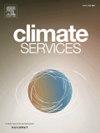Crop choice advisory for the West African Sudan Savanna based on soil type and presowing rainfall forecasts: A machine learning residual model approach
IF 4.5
3区 环境科学与生态学
Q2 ENVIRONMENTAL SCIENCES
引用次数: 0
Abstract
Crop choice is a critical decision for rainfed smallholder farmers when allocating land between food and cash crops. To inform crop choice, process-based models need to simulate yield responses that are both eco-physiologically plausible and quantitatively accurate. Achieving this is difficult when data quality and scarcity hinder model calibration. Here, we present a modification of a process model simulation performed using a machine learning residual model trained to predict the error in the process model-simulated yields, relative to field experimental data, from growing conditions. Using the random forest (RF) algorithm, residual models were developed for cowpea, groundnut, soybean, maize, millet, and sorghum cultivated at three locations in Burkina Faso. The RF residual models improved the agreement between the process model simulations and the field data while preserving plausible crop-specific rainfall–yield relationships and their variation across soil types with differing water retention or drainage capacities (i.e., Lixisols and Plinthosols). Subsequently, process model simulations for 1994–2023 were adjusted using the RF residual models. The findings showed that the better performing crops varied with respect to soil type and seasonal rainfall. However, the utility of presowing rainfall forecasts for dynamic crop choice was limited by relatively high miss rates. The proposed crop choice advisory is expected to increase the income and nutrient status of smallholder farmers in dryland regions of West Africa under rainfall variability.
基于土壤类型和播种前降雨预测的西非苏丹大草原作物选择咨询:机器学习残差模型方法
在粮食作物和经济作物之间分配土地时,作物选择是雨养小农的一个关键决定。为了为作物选择提供信息,基于过程的模型需要模拟既在生态生理学上合理又在数量上准确的产量响应。当数据质量和稀缺性阻碍模型校准时,实现这一点是困难的。在这里,我们提出了一个过程模型模拟的修改,使用机器学习残差模型进行训练,以预测过程模型模拟产量的误差,相对于田间实验数据,从生长条件。利用随机森林(RF)算法,对布基纳法索三个地点种植的豇豆、花生、大豆、玉米、小米和高粱建立残差模型。RF残差模型改进了过程模型模拟与田间数据之间的一致性,同时保留了似是而非的作物特定降雨量-产量关系及其在不同保水或排水能力的土壤类型(即Lixisols和Plinthosols)之间的变化。随后,利用RF残差模型对1994-2023年的过程模型模拟进行了调整。结果表明,不同土壤类型和季节降雨对作物的影响不同。然而,播前降雨预报对动态作物选择的效用受到相对较高的失误率的限制。拟议的作物选择咨询预计将在降雨变化的情况下增加西非干旱地区小农的收入和营养状况。
本文章由计算机程序翻译,如有差异,请以英文原文为准。
求助全文
约1分钟内获得全文
求助全文
来源期刊

Climate Services
Multiple-
CiteScore
5.30
自引率
15.60%
发文量
62
期刊介绍:
The journal Climate Services publishes research with a focus on science-based and user-specific climate information underpinning climate services, ultimately to assist society to adapt to climate change. Climate Services brings science and practice closer together. The journal addresses both researchers in the field of climate service research, and stakeholders and practitioners interested in or already applying climate services. It serves as a means of communication, dialogue and exchange between researchers and stakeholders. Climate services pioneers novel research areas that directly refer to how climate information can be applied in methodologies and tools for adaptation to climate change. It publishes best practice examples, case studies as well as theories, methods and data analysis with a clear connection to climate services. The focus of the published work is often multi-disciplinary, case-specific, tailored to specific sectors and strongly application-oriented. To offer a suitable outlet for such studies, Climate Services journal introduced a new section in the research article type. The research article contains a classical scientific part as well as a section with easily understandable practical implications for policy makers and practitioners. The journal''s focus is on the use and usability of climate information for adaptation purposes underpinning climate services.
 求助内容:
求助内容: 应助结果提醒方式:
应助结果提醒方式:


